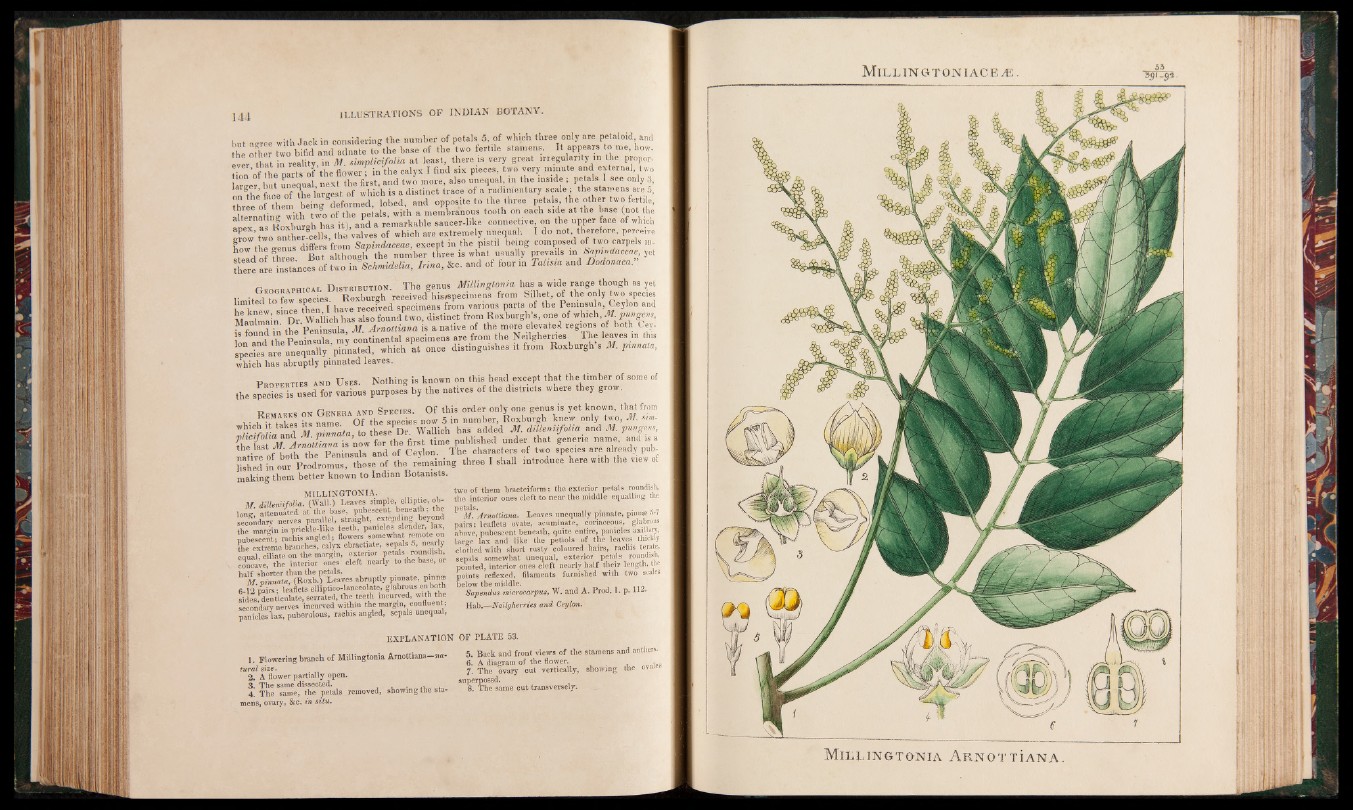
lmt acrree with Jackin considering the number of petals 5, of which three only are petalo.d and
he other two bifid and adnate to the base of the two fertile stamens. It appears to me, how.
ever that in reality, in M. simplicifolia at least, there is very great irregularity in the proportion
of the parts of the flower; in the calyx I find six pieces, two very minute and external, two
non ot the pai first and tw0 more, also unequal, in the inside ; petals I see only 3,
onThe face of the largest of which is a distinct trace of a rudimentary scale 1 the stamens are 5,
t'hree ofthem being deformed, lobed, and opposite to the three petals the other two fertile,
llterna ing with two of the petals, with a membranous tooth on each side at the base (not the
anex as Rolburgh has it), and a remarkable saucer-like connective on the upper face of which
apex, as k oxd g , J ’va]ves of wh;ch are extremely unequal; I do not, therefore, perceive
howWthe genus differs’from Sapindaceae, except in the pistil being composed of two carpels m-
1 , 1 Of fhree But although the number three is what usually prevails in Sapindaceae yet
there I mTances of ZoToSchrmdetia, Irina, &c. and of four in Talisia and Dodonaea."
G eographical D istribution. The genus Mdhngtonm has a wide range though as yet
lim ité to few species. Roxburgh received hisrspec,mens from S.lhet, of the only two species
h?knew s nie then, I have received specimens from various parts of the Peninsula, Ceylon and
M a u S n Dr. Wa lich has also found two, distinct from Roxburgh s, one of which, M pun gem,
Maul main, u . Amottiana is a native of the more elevated regions of both Cey-
L and he Pen n " " ™; continental specimens are from the Neilgherries. The leaves ,n this
s p e d i are unequally pinnated, which at once distinguishes it from Roxburgh s M. pvanala,
which has abruptly pinnated leaves.
P r o p e r t ie s and U se s . Nothing is known on this head except that the timber of some of
the species is used for various purposes by the natives of the districts where they grow.
_ „ „ „ , Kn Spfcies. Of this order only one genus is yet known, that from
V h 'Makes :ts name Of the species now 5 in number, Roxburgh knew only two, M. um-
M ninnata to these^Ir. Wallich has added M. dillemifoha and M. pun gem,
Amottiana is now for the first time published under that generic name, and is a
the last M. A _ d 0f Ceylon. The characters of two species are already pub-
S B threeishai1 in,roduce ■ H H I making them better known to Indian Botanists.
MILLINGTONIA. ,
M. dilleniifol’a, (Wall.) Leaves simple, elliptic, oblong,
attenuated at the base, pubescent beneath, the
secondary nerves parallel, straight, extending beyond
the marrfn in pricSle-like teeth, panicles slender, lax,
nubeTceSt; rachis angled, dowers somewhat remote on
the extreme branches, calyx ebractiale, sepals 5, nearly
equal, ciliate on the margin, extenor petals roundish,
concave, the interior ones cleft nearly to the base, or
half shorter than the petals. ,
M .p inm ta , (Roxb.) Leaves abruptly pinnate, pinn*
6-12 pars, leaflets elliptico-lanceolate, glabrous onboth
sides, denticulate, serrated, the teeth incurved, with the
secondary nerves incurved wlthm the margin, confluent,
panicles lax, puberulous, rachis angled, sepals unequal,
two of them bracteiform; the exterior petals: roundish,
the interior ones cleft to near the middle equalling the
petals. . * . -».
M. Amottiana. Leaves unequally pinnate, pinn® a-/
pairs; leaflets ovate, acuminate, coriaceous, glabrous
above, pubescent beneath, quite entire, panicles axillary,
large lax and like the petiols of the leaves thickly
clothed with short rusty coloured hairs, racliis terate,
sepals somewhat unequal, exterior petals roundish,
pointed, interior ones cleft nearly half their length, the
points reflexed, filaments furnished with two scales
below the middle. _ , , n o
Sapendus microcarpus, W. and A. Prod. I. p.
Hab.—Neilgherries and Ceylon.
EXPLANATION OF PLATE 53.
1. Flowering branch of Millingtonia Amottiana natural
size.
2. A flower partially open.
3. The same dissected. , t . , .
4. The same, the petals removed, showing tne stamens,
ovary, &c. in situ.
5. Back and front views of the stamens and anthers.
6. A diagram of the flower. mllpo
7. The ovary cut vertically, showing the ovui
superposed.
8. The same cut transversely.
MILLINGTONIACEÆ
MlIuHNGTO-NIA A r n o t t i a n a